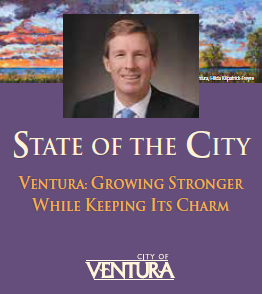Mayor Nasarenko stated “Ventura remains a magnificent and unique city to live in” during his State of the City presentation.
by Ventura Mayor Erik Nasarenko
Ventura has so much to celebrate, for it remains a well-managed and beautiful beach town that Sunset Magazine recently described as the “off-ramp to paradise.”
In terms of our fiscal management, revenues taken in by the city have exceeded expenditures since 2013, meaning Ventura is living within its means, balancing year-over-year budgets and even ending recent fiscal years with a slight surplus. Growth in the transient occupancy tax—commonly referred to as the hotel bed tax—along with increases in sales and property taxes have strengthened the city’s financial position and enabled residents to receive outstanding police, fire and park services, among other city-delivered benefits.
Last November’s successful Measure O campaign, which nearly 59 percent of Ventura voters supported, will bring an additional $11 million annually to city coffers, with the first quarterly installment due to arrive this July. Residents can expect to see the city perform immediate infrastructure improvements with the much-needed revenue, including street repaving, sidewalk repair, tree well maintenance and landscaping of road medians. As promised in the ballot statement, the city will also allocate funds to maintain Fire Station 4 and its 9 firefighters and paramedics so that east end residents continue to receive rapid and effective fire and paramedic response. I would also like to work with my colleagues to complete Ventura Community Park and fulfill the 2005 Master Plan by creating sports courts and a library component for one of Ventura’s largest recreational centers.
As the city grows, so, too, do many of its flagship businesses. The worldwide outdoor apparel company and environmental steward Patagonia is scheduled to expand its Westside campus. Similarly, the Trade Desk, which started with literally one desk eight years ago in office space adjacent to city hall, is now a publicly-traded tech company on the NASDAQ stock exchange that is looking to expand its Chestnut-street headquarters.
The health care industry in Ventura will see major changes in 2017 as Ventura County Medical Center (VCMC), Community Memorial (CMH)and Kaiser are all expected to open new medical facilities in the year ahead. These wellness enterprises will not only bring high-paying jobs to Ventura but will also provide residents with outstanding emergency, acute and long-term care.
But, like many cities across California, Ventura faces an array of fiscal pressures, some known and others still uncertain. For example, escalating retirement costs will continue to encroach upon our budget, especially given the fact that the California Public Employee Retirement System (CalPERS) recently told its member cities—like Ventura—that it is downgrading its assumed rate of return on its investments, which means we will have to make up the shortfall internally, an amount expected to climb above $6 million over the next several years. The city has already budgeted this expected increase into its long-term fiscal outlook, recognizing that—based upon predicted revenue—we should be able to absorb the new costs. But if the economy begins to retract or CalPERS reduces its assumed investment return further, this forecast could easily change.
Speaking of uncertainty, the city is unsure of how much funding, if any, it will receive from Washington, D.C. in the form of Community Development Block Grants, or CDBG funds. Historically used to help fund assistance for low-income mobile home residents, the Avenue library, and the winter warming homeless shelter, among other worthy projects, CDBG dollars are at risk of being defunded, according to the National Conference of Mayors. This loss would hurt Ventura, particularly its most vulnerable residents.
And water scarcity, despite the heavy rains, will remain a major challenge and fiscal stress for Ventura. According to the U.S. Drought Monitor, much of Ventura and Santa Barbara counties remain in “Extreme Drought,” the only two counties statewide to be given this designation. With Lake Casitas at only 38 percent of capacity and groundwater basins subject to new state and local regulations, Ventura has to identify new sources of water. To this end, the city is now studying a connection with the State Water Project, a system of canals, pipelines and channels that brings water from the Sacramento-San Joaquin Delta and Colorado River to Ventura County and much of southern California. The city is also exploring construction of a water reuse facility that would treat wastewater to the highest cleaning standards and subject it to strict safety and regulatory scrutiny before returning drinkable water back to the customer.
Finally, we are making progress to address homelessness in the city. Next month the city council will consider a change to its zoning laws that would broaden the geographic area of Ventura where crisis housing and supportive services, such as mental health counseling, substance abuse assistance and housing advice, can co-locate. The proposed regulations would allow for a maximum 55-person occupancy for up to six months, utilizing either a re-purposed structure or a new building. I look forward to working with my colleagues to begin a serious discussion about using Measure O funding to jump start the project in conjunction with other government, non-profit and private sector supporters.
Ventura remains a magnificent and unique city to live in, and the Ventura City Council is dedicated to keeping it that way. Whether you enjoy an afternoon looking at the boats moored at our Harbor, or prefer a walk along the Ventura Botanical Gardens before dining at a local (not chain!) restaurant Downtown, Ventura has something to offer for everyone. Let’s continue to work together to grown stronger while maintaining our charm.

